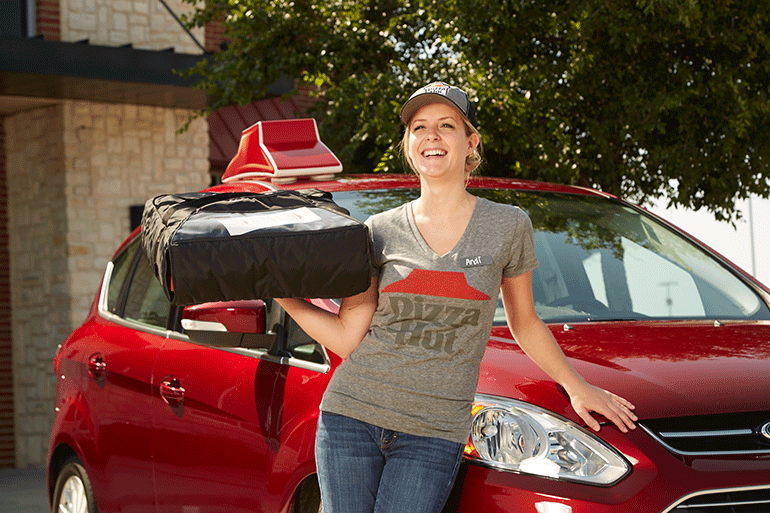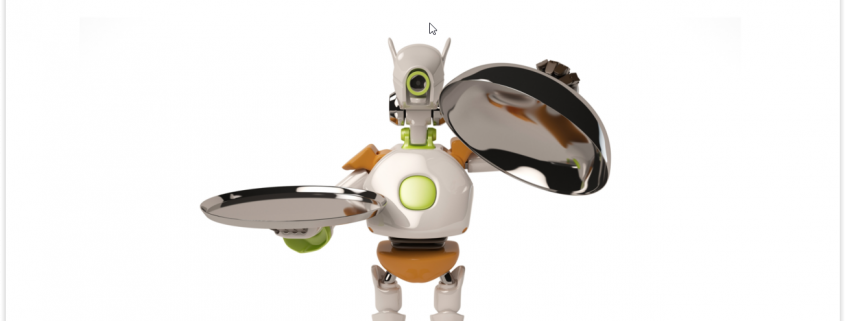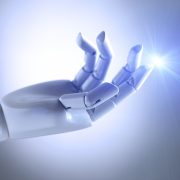BARE Shares – Will Automation Supplant the Restaurant Worker?
BARE International shares an article from Nation’s Restaurant News.
In a monthly series, menu trend analyst Nancy Kruse and NRN senior food editor Bret Thorn debate current trends in the restaurant industry. For this installment, the two discuss robots in restaurants.
Nancy Kruse on the rise of robots:
 ‘When it comes to research, I’m stubbornly low tech. I’m embarrassed to admit, Bret, that I keep old-fashioned subject files full of clippings on hot topics, a practice that I returned to after an early, unsuccessful attempt to go paperless. (Don’t judge me, but I also prefer real books to Kindles and traditional newspapers to iPads.) Based on the burgeoning size of my file on the subject, it is ironic, then, that robotics and their impact on the restaurant industry is a major hot-button issue of the moment. Just consider this random sample of articles:
‘When it comes to research, I’m stubbornly low tech. I’m embarrassed to admit, Bret, that I keep old-fashioned subject files full of clippings on hot topics, a practice that I returned to after an early, unsuccessful attempt to go paperless. (Don’t judge me, but I also prefer real books to Kindles and traditional newspapers to iPads.) Based on the burgeoning size of my file on the subject, it is ironic, then, that robotics and their impact on the restaurant industry is a major hot-button issue of the moment. Just consider this random sample of articles:
• In June, Entrepreneur magazine asked the rhetorical question “When Will Robots Finally Take Over the Fast-Food Business?” and proceeded to forecast that quick-service dining is inevitably headed to a largely automated future.

• Operators who have jumped into robotics have predictably grabbed headlines, like Zume, a pizza joint in Northern California that uses robots to make its pies. Down the coast a few hundred miles, Pasadena, Calif.-based CaliBurger uses a robot to flip hamburgers, and airport-concessions titan HMS Host has tested a robot at one of its pubs to engage consumers with its food and drink offerings. As an aside on these last two, there seems to be an attempt to humanize the bots; the former is dubbed Flippy and the latter is called Pepper.
• It’s not surprising that early digital adopters like Domino’s Pizza, which blazed a trail and boosted its business with its sophisticated ordering app, are actively experimenting with robots. After its initial trial run in New Zealand, Domino’s DRU delivery robot was dubbed “cheeky and endearing” in a press release, another example of anthropomorphism that suggests the little guy dispenses one-liners and hugs along with its pizza.
• The topper, though, is surely KFC’s H.A.R.L.A.N.D., a robotic Colonel Sanders that accosted unsuspecting customers at selected drive-thru locations and used technology to make the drive-thru operator’s voice sound just like Sander’s Kentucky drawl. As a promotional gambit, it may have been superior to some of his white-wigged, real-life impersonators, like the unnaturally tanned, B-list actor George Hamilton, who portrayed him in a TV commercial sometime back.

At CaliBurger, a robot named Flippy flips hamburgers.
While there’s obviously a great deal of interest in the subject, I think it’s a little early to say exactly how robotics will impact our business in the long term. Of course, that hasn’t stopped legions of prognosticators and doomsayers, most of whom maintain that this all spells the end for low-income workers, especially those in the back of the house. But early results suggest otherwise. The Entrepreneur story quoted a scary statistic from consultants at McKinsey & Company that estimated that a hefty 73% of foodservice activities have the potential to be automated. However, there’s a distinct disconnect so far between potential and actuality, as the article goes on to describe how Panera Bread’s ambitious 2.0 initiative to implement mobile and kiosk ordering has actually resulted in more employees per location. It turns out that digital ordering increases both the volume of orders and their size, which necessitates extra labor to handle the flow. And while Zume Pizza executives say that the operation does employ fewer people than comparably-sized competitors, the chairman of CaliBurger believes that Flippy won’t replace workers, but will free them up for less repetitive tasks that add value to the patron experience.

It strikes me that a couple of things are worth keeping in mind as the debate revs up, which it certainly will. First, in all the piles of papers written on the technology, none has suggested that robots can or will replace the creative talents of the chefs who cook up innovative dishes in the kitchen, negate the continuing importance of the face-to-face factor that is the foundation of hospitality in the dining room, or displace the talented concept developers including those behind Zume Pizza and CaliBurger, who keep the industry vital and vibrant.
There’s also a sense of déjà vu all over again, as the robotics uproar harks back a time maybe 25 years ago, when we found ourselves enmeshed in a similar controversy.
Computers were coming into their own and bringing with them dire predictions about the outlook for the foodservice sales function. Sales reps for distributors and manufacturers were put on the endangered species list, the futurists insisted, and slated to be replaced by the customer’s computer keypad.
It’s evident that no such thing transpired. The computer didn’t replace human interactions; rather it made them faster and more accurate, facilitated the flow of information and enhanced problem solving. As a bonus, it also relieved weary reps from having to lug around a 30-pound order book.

KFC has a robotic Colonel Sanders named H.A.R.L.A.N.D. that appeared at select drive-thru locations and used technology to make the operator’s voice sound just like Sanders.
My hunch is that we’ll see a similar dynamic here, as robotics ultimately helps foodservice employees rather than hindering them, and reorganizes them, but doesn’t replace them. Having already confessed my Luddite use of clipping files, Bret, this discussion is a bit above my pay grade. So would you care to wade into the debate? I’m interested in your thoughts on the subject, and just for the record, I don’t believe you have anything to fear when it comes to man vs. the machine. In my humble opinion, you’re way too cheeky and endearing to ever be replaced by a robot.
 Nancy, I love technology. I love it! I love my Kindle that weighs less than a book, doesn’t use paper and lets me look up the meanings of words just by touching them. I love my completely searchable computer files of old menu items that can tell me, for example, what chains used asparagus last spring. I like catching up on the news on my laptop or phone (I don’t have an iPad; I love technology, but I’m also cheap).
Nancy, I love technology. I love it! I love my Kindle that weighs less than a book, doesn’t use paper and lets me look up the meanings of words just by touching them. I love my completely searchable computer files of old menu items that can tell me, for example, what chains used asparagus last spring. I like catching up on the news on my laptop or phone (I don’t have an iPad; I love technology, but I’m also cheap).
I don’t have much use anymore for newspapers or magazines — I don’t miss their feel or smell or whatever people nostalgic for those things miss — and although my desk is cluttered with cookbooks and other paraphernalia, they’re just there because I can’t figure out who to give them away to.
I look forward to what new technology has to offer, in foodservice as much as in any other facet of life. Panera Bread and other chains have already seen success with people ordering and paying for their food online and then showing up to collect their order that’s already waiting for them on a shelf. It’s seamless and free of cumbersome interactions with humans.
I like humans, but on the transactional occasion that a limited-service restaurant experience generally is, I don’t see a need for one to be between me and my sandwich.
And there are concepts like Eatsa, where guests order, customize and pay for everything via kiosk. It’s then assembled behind closed doors (Eatsa’s founders indicate that there’s some automation in the meal preparation, but they also insist that the details are secret) and appears in a window for the customer to collect, like magic.
Or like an automat from the 1950s.

At Eatsa, customers pick up their orders in a cubby.
People have been worried about robots taking our jobs since the term was coined, according to a National Public Radio story from 2011, in 1920 by Czech playwright Karel Čapec. According to science historian Howard Markel, the word was derived from “rabota,” an Old Church Slavonic term for “forced labor,” and Čapec used it in the play R.U.R. or Russum’s Universal Robots, to describe soulless people — flesh-and-blood, not metallic — who were mass-produced to do all of our work for us.
As robots almost always do in fiction, they eventually rebelled and killed most of the humans.
In 1952, Kurt Vonnegut Jr. wrote Player Piano, about a dystopian future in which humans are divided between scientists and such who have jobs, and everyone else, who has been essentially outsourced by machines.
It’s an old, tired, but nonetheless terrifying plot that gets recycled with each generation, both in reality and in fiction.
I agree with you that restaurants will see more automation, and I also agree with you that the results will be that workers’ jobs will change. The Panera example that we both cited illustrates that beautifully.
As the chain becomes more efficient, more people are required to prepare the food, but also as technology shifts, as a Panera executive explained to me as their 2.0 system was being implemented, humans have to be available to help guests with the ordering kiosks.

Panera Bread’s initiative to implement kiosk ordering has resulted in more employees per location.
Additionally, Panera has worked to make its service better, hiring people to deliver food to tables for those who dine in the restaurant.
I recall that a few years ago you coined a phrase “high tech, high touch.” The technology improves on clunky points of friction like ordering and payment, while human beings check in with customers to make sure they’re happy and to resolve any problems that come their way.
Another example is Pizza Hut, which is simultaneously improving its delivery algorithm to be more efficient, but also hiring 14,000 more drivers to carry out that more efficient delivery.

Pizza Hut is improving its delivery algorithm to be more efficient, but also hiring 14,000 more drivers to carry out that more efficient delivery.
Will self-driving cars eventually replace those drivers? Maybe, and that could well free up those drivers to fill some yet unforeseen role. I don’t know what it would be, but here in the publishing world we have a whole team of people whose job is “engagement” or figuring out the best strategies to present our words in ways that will be efficient and enjoyable for our online readers
That wasn’t a thing when I started this job 18 years ago, working for what at the time was a weekly news magazine.

Self-driving cars may eventually replace delivery people, freeing them up to fill some yet unforeseen role.
Ah, but what about the kitchen? Surely automation will cut labor there, you might say.
Perhaps, but it seems to me that just as human hospitality remains important in many front-of-the-house situations, culinary creativity is also at the heart of foodservice.
You probably have read about efforts by the IBM supercomputer Watson to develop menu items. Back in 2014 the machine that was able to win at Jeopardy and is reportedly being put to work to help cure cancer also was put to work in menu ideation at the Institute of Culinary Education in New York City.
The IBM supercomputer Watson has been put to work in menu ideation.
Watson was fed a huge database of recipes, nutritional information and data on the molecular composition of ingredients. Then it was instructed to come up with flavor combinations from different culinary traditions — say, Baltic combined with Korean and North African — combining them in a way that chefs wouldn’t have thought of. The chefs could specify the protein or other key ingredients they wanted to use and Watson would spit out combinations that might not have gone together traditionally, but that ought to work from a molecular perspective.
But all Watson could do was list ingredients. It was still up to chefs to develop dishes from them, and I think it will stay that way for many years to come.
Oh, and thanks for valuing my cheekiness and endearing qualities over DRU’s, but let’s wait and see what the next round of artificial intelligence looks like.’
***
The Restaurant & Hospitality industry has been the cornerstone of BARE’s business since launching in 1987. BARE’s Hospitality department supports clients with dedicated program specialists who become brand ambassadors and serve as the main point of contact. Our Hospitality evaluators have strict ethical standards and are trained to methodically assess every area of a property from the reservation call to the valet departure and every point in between.
Contact us today to find out more.












